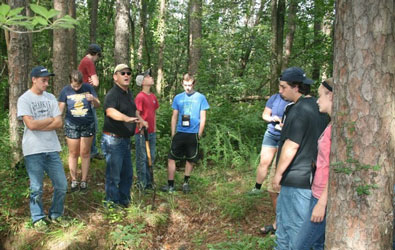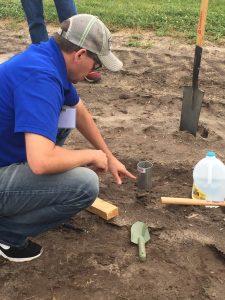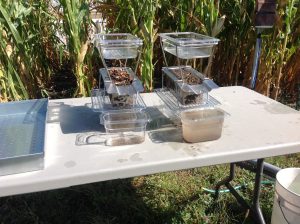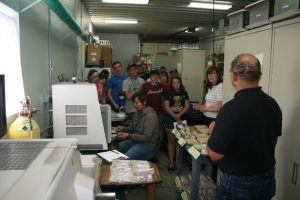 Looking to incorporate citizens into on-farm research? There are many different types of individuals, activities, and partners to consider incorporating. Most of all, it is important to ensure those activities fit into your research protocol. Learn how through the resources below.
Looking to incorporate citizens into on-farm research? There are many different types of individuals, activities, and partners to consider incorporating. Most of all, it is important to ensure those activities fit into your research protocol. Learn how through the resources below.
 Sometimes collection of data can be a big project. If you’ve ever heard the phrase “many hands make light work”, know that it can apply to some aspects of on-farm research. Citizen scientists may be available to take in-field, real-time, soil health measurements such as:
Sometimes collection of data can be a big project. If you’ve ever heard the phrase “many hands make light work”, know that it can apply to some aspects of on-farm research. Citizen scientists may be available to take in-field, real-time, soil health measurements such as:
- Cover crop biomass data
- Soil slaking data
- Water quality data
- Infiltration
- Bulk density
- Penetrometer readings
- Earthworm counts
- Residue measurements
- Soil Temperature
- Whitey-Tighty/ Tea bags Demo
The table below is a list of possible resources and lessons for teaching citizen scientists.
| Source | Resource | Description |
|---|---|---|
| Soil Science Society of America | K-12 Soil Science Teacher Resources | Various, numerous soil topics and activities listed by grade level; many related to soil health though not labeled as such. |
| USDA-Natural Resources Conservation Service | Soil Health for Educators | Links to soil health lesson plans (PDF) and provides YouTube videos. Also describes the soil quality test bucket. |
| USDA-Natural Resources Conservation Service | Soil Quality Test Kit | Describes USDA-NRCS Soil Quality Test Kit and provides a link to PDF Guide to using the kit. |
| Good Housekeeping | 10 Easy Soil Tests that Pinpoint Your Garden’s Problems | Simple observations that can be made about soil with explanations as to why each is important. |
| University of Nebraska-Lincoln Institute of Agriculture and Natural Resources Crop Watch | Youth Soil Quality Lessons and Videos | Similar to USDA-NRCS Soil quality test bucket site. |
| MO DIRT: Missourians Doing Impact Research Together | Soil Science Curriculum | Information/activity sheets on soil components, texture, structure and water relations, and formation |
| Journal of Extension | Soil Health Educational Resources | Three soil health and cover crop demonstrations |
| Journal of Extension | Three Soil Quality Demonstrations for Educating Extension Clientele | Three soil demonstrations show how soil organic matter increases water holding capacity, improves soil structure, and increases nutrient retention. |
| Department of Agronomy, Purdue University | Demonstrations in Soil Science | Mostly college laboratory-level demonstrations. Some could be adapted for other audiences |
| Soil Science Society of America | Soil Experiments and hands-on Projects | Various links to soil experiments and projects |
| National Agriculture in the Classroom | National Agricultural Literacy Curriculum Matrix | Lesson plans for “Properties of Soils (Grades 9-12)” |
If you have a group that is already collecting soil information, you might consider helping other organizations gather data by learning more about larger projects and initiatives related to soil health. Below is a list of potential projects to consider.
| Source | Resource | Description |
|---|---|---|
| The Globe Program | Pedosphere (Soil) Community | The Global Learning and Observations to Benegfit the Environment (GLOBE) Progam is a world-wide citizen science and education program. Subsections include “Atmosphere”, “Pedosphere”, “Biosphere”, “Hydrosphere” and “Earth as a System”. |
| Geoderma | Can Citizen Science assist digital soil mapping? | Article describes citizen science and initiatives world-wide in soil science. It evaluates whether citizen science may aid digital soil mapping. |
| Geo-Wiki | Engaging Citizens in Environmental Monitoring | Several soil-related opportunities exist to validate global land cover maps. Sometimes competitions are held. |
| Scientific American / The University of Oklahoma Citizen Science Soil Collection Program | What’s in your backyard? | Citizen scientists send in soil samples in hopes of finding new natural products and cures for diseases from the soils’ microbes. |
| Environmental Protection Agency | Citizen Science for Environmental Protection | Defines citizen science. List citizen science projects supported by the EPA. Provides resources concerning citizen science. |
| Missouri Epscor | MO DIRT: Missourians Doing Impact Research Together | Citizens can collect soil health data as individuals or as teams. Training, a manual, and a soil kit are provided. Confined to Missouri. |
| Knoll Environmental | Free Arsenic Testing | Send soil samples in to be tested for arsenic. The project aims to 1)use social media to help gather data, and to identify areas in the United States that have arsenic concentrations |
 Sometimes, the best learning tool is discussion. Encourage farmers to create their own local network to discuss soil health topics. Some ideas might include:
Sometimes, the best learning tool is discussion. Encourage farmers to create their own local network to discuss soil health topics. Some ideas might include:
- Using social media or group texts to report to each other what they are seeing in their fields or ask questions about what they are seeing in their fields.
- Reporting runoff events (Water Quality)
- Participating in
- online forums like Ag Talk
- Social media groups like Everything Cover Crops
- Conversations about soil health tests
